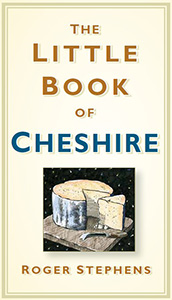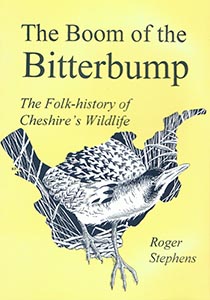Books
The Little Book of Cheshire

The Little Book of Cheshire (published in 2018) is one in the series called "The Little Book of ...", published by The History Press. The Little Book of Cheshire is a fast-paced, fact-packed compendium of the sort of frivolous, fantastic or simply strange information no one will want to be without. Here we find out about the most unusual crimes and punishments, eccentric inhabitants, famous sons and daughters and hundreds of other facts, plus some authentically bizarre bits of historic trivia.
Here are some snippets from the book:
- Cheshire, during the medieval period, was a county palatine, ruled separately from the rest of England, with a parliament all to itself. In those days, it was not considered strange to say something like, “He left Chester and returned to England”. In 1398, King Richard II raised the county’s status still further: making it a Principality – the only English county ever to receive this honour. Sadly, Richard was deposed the following year and the new King reversed the action, but a sense of proud separation and difference remained.
- The archers who won glory for England during the Hundred Year’s War hailed, overwhelmingly, from Cheshire. It was largely their courage and expertise which won the battles of Crecy, Poitiers and Agincourt and many others. In time, they came to be feared all over Europe and created a legend that endures to this day.
- According to a law made in 1403, it is illegal for “a Welshman of either sex” to remain within the walls of Chester after nightfall, or to congregate in groups of three or more. They are also barred from carrying weapons or entering a pub! The punishment? Death by decapitation. However, relations with the Welsh have always been complicated, and the commonest surname in Cheshire today is not Smith, but Jones!
- Cheshire cheese is England’s oldest named cheese, with roots in the early medieval period. In 1590, it became the first cheese to be exported from its own region, when the court of Queen Elizabeth ordered large amounts of it for the Privy Council’s dinner. Before long, it crossed the channel and, like the Cheshire archers, made an impression on the French. Real farmhouse Cheshire has a clean, milky, slightly salty flavour which lingers in the mouth as it crumbles, a quality unmatched by any other variety.
- The Cheshire Plain has been called “the Pond Capital of Europe”, because of its wealth of small ponds. Most of them were created, centuries ago, by gangs of “marlers”, itinerant labourers who dug down to reach the fertile marl soil which was used as fertilizer. There are many larger areas of water too: tranquil meres such as Rostherne and Combermere, and flashes caused by subsidence. It has even been claimed that, after the Lake District itself, no other English county has a greater surface of land covered in water!
- The city of Chester, according to an opinion poll published in the magazine USA Today in 2013, is the fifth prettiest city in Europe. Few, looking at the splendour of Eastgate Street, would argue with that opinion: the city has 650 listed buildings, many containing medieval – or even Roman – stonework. In Victorian times, local architects such as John Douglas added some touches of their own; they borrowed ideas from ancient “Cheshire magpie” buildings like Little Moreton, Bramall and Adlington Halls to blend old and new, turning Chester into a city like no other.
- The birthplace of that great north country institution the brass band was not Yorkshire, or even Lancashire, but the town of Stalybridge, which until 1974, was in Cheshire. The Stalybridge Old Band really is old, so old, in fact, that it performed at a political rally in St. Peter’s Fields, Manchester on the 16th August 1819, an occasion later to become infamous as “the Peterloo Massacre.” Cheshire is also home to two of the finest bands in the world: the Fodens Band from Sandbach and the Fairey Band from Stockport.
- The village of Willaston, near Crewe, hosts the world championships of a gentler and more eccentric sport: worm charming! Every year, competitors flock to the village to see how many worms they can charm out of the ground, using every method imaginable. The current world record holder is Sophie Smith, a native of the village, who in 2009, aged ten, managed to charm 567 worms in half an hour.
This is an ideal book to have by your bedside or to while away the hours on a long train journey. And if you like to take part in pub quizzes - or set them - then you will find this book a veritable treasure trove of useful information.
The Boom of the Bitterbump

The Boom of the Bitterbump by Roger Stephens (published in 2003) tells the human story of Cheshire’s wildlife, from primeval times to the present day. Over a period of eight years, the author gathered the memories, knowledge and superstitions of Cheshire people - gamekeepers and poachers, farmers and labourers, wildfowlers and fishermen. In addition, he wrote more than thirty magazine articles on the subject which appeared in "The Grebe" (the magazine of the Cheshire Wildlife Trust) between 1999 and 2010. This helped to popularize the project and brought in contributions from all over the county.
The book follows in illustrious footsteps: those of such great Cheshire naturalists as T A Coward and A W Boyd, who, though their scientific knowledge was second to none, were nonetheless willing to learn from their rural neighbours.
The book is adorned with more than fifty illustrations by the author.
Copies of The Boom of the Bitterbump are available in most Cheshire bookshops, online from Amazon, or from the publisher Gordon Emery www.gordonemery.co.uk
View a sample
Please click on the following link to view a sample extract of "The Boom of the Bitterbump". To view this extract, you will need to have a FREE software utility called Adobe Reader installed on your system. If you do not have this software installed on your PC, you can obtain and install your FREE copy now by clicking this link for Adobe Reader.
The Wharncliffe Companion to Chester

Aimed at visitors and residents alike, The Wharncliffe Companion to Chester by Roger Stephens is an indispensable reference guide to the long, varied and sometimes surprising story of the city. Essential information on the people, places and events that played key roles in its history is presented in a convenient A to Z format. The story is told with the help of eighty fascinating old drawings and photographs.
The book draws on the authors twelve-year experience as a Chester tourist guide and local historian.
The Wharncliffe Companion to Chester is available from Chester bookshops, or from the publisher Pen and Sword Books Ltd. www.pen-and-sword.co.uk
View a sample
Please click on the following link to view a sample extract of "The Wharncliffe Companion to Chester". To view this extract, you will need to have a FREE software utility called Adobe Reader installed on your system. If you do not have this software installed on your PC, you can obtain and install your FREE copy now by clicking this link for Adobe Reader.
